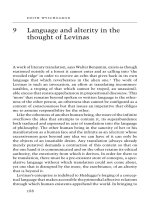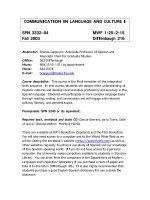Language and Culture
Bạn đang xem bản rút gọn của tài liệu. Xem và tải ngay bản đầy đủ của tài liệu tại đây (2.02 MB, 32 trang )
Language and Culture
Language, Communication, and
Culture
Introduction to Language,
Communication, and Culture
How is language related to culture?
How is a language related to a culture?
Both questions are valid, and we look at the issues through several
lenses:
Kinesics and paralanguage
Ethnolinguistics and code switching
Similarities and differences between human and animal
communication.
Nonverbal Communication
There are two basic types of nonverbal communication
Kinesics involves the all-too-familiar body language: facial
expression, gestures, even eye contact
Paralanguage are the vocalizations that often accompany speech:
slurs, tones of voice, nonmeaningful utterances including “um” and
“uh”
Kinesics: Gestures
Kinesics: System of analyzing
postures, facial expressions, “body
language”
See that thumbs up? This gent
likes whatever you’re doing.
Buying his brand of coffee,
perhaps?
In other countries, it would mean
—well, you know! (Need a hint?
Think middle finger)
This is one example how the
same gesture might mean
different things in different
cultures.
Kinesics: Facial Expressions
Social smiles are commonplace,
though women may do so more
than men—a matter of expected
social sensitivity
Frowns express frustration,
sometime cynicism, as this cartoon
suggests—if you smile, you’re
naïve
Facial expressions and eye
contact are the most widely used
forms of kinesics; gestures are
also frequent
Gesture Call Systems:
Paralanguage
Paralanguage consists of
extralinguistic noises
accompanying language
Voice qualities: tone, slur
(cartoon), other background
noises
Vocalizations: Identifiable
noises turned on and off at
short intervals—”uh,” “um,”
other kinds of hesitation
More Paralanguage
Vocal characteristics:
Sound production such as
laughing
Vocal qualifiers: Tone or
pitch-”Get Out!”
Segregates: “Shh!” “Oh
oh,” “hmmm!” (cartoon)
among others
Historical Linguistic Techniques
When tracing the history of language, linguists have no writing
to rely upon
Several techniques have been developed to trace the
probable changes
Glottochronology: the reconstruction of past languages on
the assumption that 14% of a language changes every 1000
years
Core vocabulary: Comparison of words for common objects
based on similarity
A list of words is compiled for each of two languages that refer
to objects that are common everywhere: body parts, sun, rain,
stones, trees, and others
The closer the vocabulary—cognates or similar words
between two languages, the more closely related the two
languages are thought to be.
Models of Language Change
Language Family
Group of languages descended from a single
ancestral language
Example: Indo-European is descended from
Proto-Indo-European
Family Tree Model: a model that emphasizes
the derivation of language from a common
source
Wave Model: A model that emphasizes
borrowing across contemporary languages
Ethnolinguistics
Definition: Study of relationship between
language and culture
Named after Edward Sapir (top) and
Benjamin Lee Whorf (bottom), the
Sapir-Whorf Hypothesis states that
language,
By providing habitual “grooves” of
expression
Predisposes people to see world in
certain ways
Thus guiding thinking and behavior
Ethnolinguistics: Do Languages
Structure Cultures. . .
Example of Sapir-Whorf
hypothesis;
Hopi: Conception of time as
processes, not discrete units
For example, Hopi would not
divide time into seconds or
hours
Nor would they perceive time
as object, such as wasting time
Or Do Cultures Structure Language
The Nuer of the Sudan are cattle
herders
Children are named after cattle, and
poetry is composed about them
More than 400 words are related to
cattle
In our own culture, we have a
militaristic vocabulary; we make a
killing on Wall Street, we bomb the
exam, we have a war on drugs,
cancer, poverty, you name it
So we have a chicken and egg
question
Does language condition culture
Or does culture condition language?
Ethnolinguistics: Some Areas of
Research
Kinship terms: The terms father and mother may be
extended to uncles and aunts. More on this later
Gender-based meanings: When women say “I’m sorry,”
are they taking responsibility for the problem or are they
regretting the situation, as Deborah Tannen argues.
We have several social dialects in this country, ranging
from Afro-American speech to “Spanglish” (SpanishEnglish word combinations) to regional dialects from the
U.S. South, y’all, to Bostonian bahgains.
Code Switching: Martin Luther King
We change our speech styles to fit
the occasion
Code Switching: Switching style of
speech according to occasion and
audience
Martin Luther King, Jr., was a master
in code switching, ranging from
standard discourse in formal settings
(Washington Monument, 1963, I
Have a Dream speech upper photo)
To informal discourse in black
settings (Here delivering a sermon at
the Ebenezer Baptist Church in
Atlanta, Georgia)
Language Origins: Interspecies
Comparison
When language began is anyone’s guess
Defining communication and comparing different communication
systems is a first step
Chimpanzees have used American Sign Language and computer
buttons to convey messages somewhat like languages
But speech organs have long since deteriorated, so we have at best
indirect evidence.
Language Origins: Fossil Evidence
Did Neanderthals have language? A humanlike
hyoid bone, which anchors the tongue, was
found in Kebara Cave, Israel
Endocasts indicating size of cerebrum and
possible Broca’s area have been found among
Homo habilis remains
Another indication is the flat surface at the skull
base, suggesting the larynx was too high to
enable language; nonhuman primates also have
a flat skull base and high larynxes
Basic conclusion: no one really knows when
language got its start
Features of Language Shared
with Other Species
Nevertheless, language does share some features with the
communication systems of other animals.
We look at some examples, such as gibbons, stickleback courtship,
and bee dances indicating the location of a nectar source
Common Features of Language
and Nonhuman Communication
Arbitrariness
Productivity
Interchangeability
Displacement
Specialization
Cultural Transmission
Arbitrariness
Definition: Absence of intrinsic
relation between
communication element
(speech sound) and thing or
event to which it refers
(referent)
Iconic Relationship:
Existence of such a
relationship between element
(e.g. gesture) and its referent
Importance: Utterance is not
“married” to meaning, such as
this gibbon’s warning call
Arbitrariness (Examples)
Example [k], [æ], and [t] are not
meaningful in and of themselves
Meaning emerges when sounds are
combined:
[kæt] “cat” has one meaning (feline, the
one who caught a mouse)
[tæk] “tack” has another (small nail)
[ækt] “act” has a third (dog and pony
show)
Even then, this string is language
specific (English), not intrinsic
Arbitrariness (Across
Languages)
Evidence of Arbitrariness: Diverse Languages
“Cat” has different pronunciations in different
languages
Similarities are the product of common roots and/or
diffusion from one language to another
Productivity (Definition)
Productivity is the capacity for
elements of communication system
to be combined to form new
meanings which the speaker and
listener may never have learned
before, yet understands perfectly
Try this exercise: the top figure is a
wug
Now here are two of them
There are two ____
If your response was [wəgz] you
produced an entirely new—and
correct--utterance
Productivity: Jabberwocky
Riddle
From Jabberwocky by
Lewis Carroll (see
illustration}
‘Twas brillig and the sllthy
toves
Did gyre and gimble in
the wabe
Identify:
The nouns
The verbs
The adjectives
Productivity: The Answers
The nouns: surely the article the is a dead giveaway for toves and
wabe
The verbs: ‘twas is poetic English for “it was,” and the helping verb
did uncovers gyre and gimble
The adjectives: Doesn’t the –y ending of slithy suggest an
adjective, similar to slimy? And ’twas suggests brillig to be another
one.
Productivity: Language Learning
Language drills use the principle of productivity
English: I am, you are. . .
Spanish: Yo soy, tu eres. .
Productivity simply involves taking a few elements (phonemes,
morphemes, even syntax) and generate unlimited combinations of
expressions









